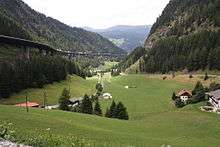Brenner Pass
The Brenner Pass is a pass through the Alps at the Austrian-Italian border, at 1,370 metres.
- This article is an itinerary.

The pass has been one of the most important passages through the Alps since ancient times. Today it is traversed by highway E45 and a railroad between Innsbruck and Bolzano. A base tunnel making the railroad both flatter and shorter than it currently is, with construction to be complete some time in the 2020s or 2030s.
In summer, the Brenner Pass is a gratifying route for hiking and cycling.
Understand
At a saddle height of "just" 1,370 m (4,490 ft) in altitude, it was one of the lowest Alpine crossings before tunnels were built. The Brenner has been one of the major alpine crossings for centuries. The Cimbri set out to attack the Roman Empire when they crossed the pass in the second century BCE and later emperor Septimus Severus had a Roman road built that was called Via Raetia and was in use until the early modern era. For a long time, crossing the Brenner was arduous and dangerous, with barely existing roads often subject to avalanches, flooding and other natural hazards. Still, it was one of the most used Alpine crossings and used by such illustrious figures as Martin Luther or Johann Wolfgang von Goethe on their trips to Italy. 1867 saw the opening of the Brenner Railway, one of the first railways crossing the Alps. Following World War I, the border between Austria and Italy came to lie on the Brenner pass. The Brenner Autobahn was built in the 1950s and 1960s and has since been one of the most important crossings from Central Europe towards Italy and the scourge of numerous German holiday-makers who sat in congestion during the summer holidays. Today, the Brenner remains one of the most important and frequently congested freight and passenger routes across the Alps and Austria, Italy and the European Union are working on improving the railway connection by building a massive base tunnel, rivaling that dug under the Swiss Gotthard massive.
Get in
If you arrive by car, keep in mind that you'll have to get a Vignette (locally called "Pickerl" by some) for the Austrian highways. The only way to avoid this is to use no highways in Austria whatsoever, which is usually not worth it. In Italy, highways have a distance based toll, with the Brenner Highway itself no major exception to this rule. The Austrian Brenner Autobahn is a "Sondermautstrecke" meaning that in theory you don't need a Vignette to drive on it, but you do need to pay the toll for that specific road. In practice, however, you'll have to use other Austrian highways to get onto this road in the first place.
Go
By car
- Brenner Autobahn. The joint Austrian-Italian motorway, designated as E45, A22 (Italy) and A13 (Austria) is a toll road and the only practicable way to cross the pass by car. It is notorious for congestion, particularly during the summer holiday season, when numerous Germans travel to Bella Italia. The Italian side has a website for the A22. Some 9€ toll on the Austrian side, some 20€ on the Italian side.
- 🌍 Europe Bridge (Europa Brücke). At the time of its construction, this was Europe's highest bridge. It is still an important part of the Brenner Highway, carrying the motorized traffic out of Innsbruck
- 🌍 Brennerstraße (B182). The old and until the construction of the Brenner Highway only road across the pass it partially follows the old Via Raetia. The main advantage is that you do not have to pay a toll, but what you might save in tolls is more than made up for in lack of speed and higher fuel consumption. The views are nicer and the curvier road is more of a challenge for drivers, though
On foot
By bike
By train
Until the construction of the new Brenner Base Tunnel, all trains - local as well as international - take the old Brenner Railway from Insbruck via Franzensfeste/Fortezza and Bozen/Bolzano to Verona. Tickets can be bought through both ÖBB and Trenitalia. Direct EuroCities take some three and a half hours from Verona to Innsbruck.